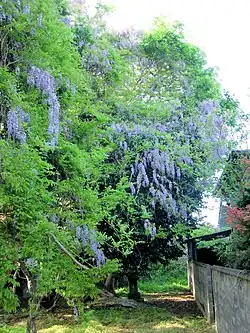藤
See also: 籐
| ||||||||
Translingual
Han character
藤 (Kangxi radical 140, 艸+15, 19 strokes in traditional Chinese and Korean, 18 strokes in mainland China and Japanese, cangjie input 廿月火水 (TBFE), four-corner 44232, composition ⿱艹滕)
References
- KangXi: page 1065, character 46
- Dai Kanwa Jiten: character 32340
- Dae Jaweon: page 1531, character 5
- Hanyu Da Zidian (first edition): volume 5, page 3321, character 5
- Unihan data for U+85E4
Chinese
| trad. | 藤/籐 | |
|---|---|---|
| simp. | 藤 | |
| 2nd round simp. | ⿱龹小 | |
| alternative forms | 𣳾 2nd round simp. (1981) | |
Glyph origin
Characters in the same phonetic series (朕) (Zhengzhang, 2003)
Phono-semantic compound (形聲, OC *l'ɯːŋ) : semantic 艸 (“grass”) + phonetic 滕 (OC *l'ɯːŋ) – a type of plant.
Pronunciation
Compounds
Derived terms from 藤
Japanese
| Shinjitai | 藤 | |
| Kyūjitai [1][2] |
藤󠄃 藤+ 󠄃?(Hanyo-Denshi) (Moji_Joho) |
 |
| 藤󠄇 藤+ 󠄇?(Hanyo-Denshi) |
 | |
| The displayed kanji may be different from the image due to your environment. See here for details. | ||
Readings
Compounds
- 藤栄 (Tōei)
- 藤八拳 (Tōhakken)
- 藤兵衛 (Tōbē)
Etymology 1
| Kanji in this term |
|---|
| 藤 |
| ふじ Grade: S |
| kun’yomi |

藤 (fuji): Japanese wisteria trees near Daizen-ji Temple in Murayama, Fukushima
⟨pudi⟩ → */puⁿdi/ → /ɸud͡ʑi/ → /ɸuʑi/
From Old Japanese 藤 (pudi).
Noun
- a wisteria, especially the Japanese wisteria, Wisteria floribunda
- Short for 藤色 (fujiiro): a light lavender color, akin to wisteria flowers
- a type of 襲の色目 (kasane no irome, “garment-layering color combination”) with the front a light purple, and the back blue
- a 家紋 (kamon, “family crest”) with designs of Japanese wisteria flowers, leaves, and/or branches
- (card games) the suit of Japanese wisteria in a hanafuda deck, representing the month of April
Usage notes
As with many terms that name organisms, this term is often spelled in katakana, especially in biological contexts (where katakana is customary), as フジ.
Derived terms
Derived terms
- 藤井 (Fujii)
- 藤色 (fuji-iro)
- 藤夫 (Fujio)
- 藤岡 (Fujioka)
- 藤笠 (fujigasa)
- 藤襲 (fujigasane)
- 藤葛 (fujikazura)
- 藤衣 (fujigoromo)
- 藤沢 (Fujisawa)
- 藤島 (Fujishima)
- 藤城 (Fujishiro)
- 藤瀬 (Fujise)
- 藤棚 (fujidana)
- 藤壺 (fujitsubo)
- 藤菜 (fujina)
- 藤布 (fujinuno)
- 藤裏葉 (Fuji no Uraba)
- 藤の袂 (fuji no tamoto)
- 藤灰 (fujibai)
- 藤袴 (fujibakama)
- 藤原 (Fujihara)
- 藤本 (Fujimoto)
- 藤原 (Fujiwara)
- 上がり藤 (agarifuji)
- 箙藤 (ebirafuji)
- 下がり藤 (sagarifuji)
- 白藤 (shirafuji)
- 土用藤 (doyō fuji)
- 夏藤 (natsufuji)
- 野田藤 (Noda fuji)
- 八藤 (yatsufuji)
- 山藤 (yamafuji)
Idioms
- 二鼠藤を噛む (niso fuji o kamu)
Etymology 3
| Kanji in this term |
|---|
| 藤 |
| かつら Grade: S |
| nanori |
Possibly from 桂 (katsura, “katsura tree, Cercidiphyllum japonicum”).
References
- 1914, 漢和大辭書 (Kanwa Dai Jisho, “The Great Kanji-Japanese Dictionary”) (in Japanese), page 1864 (paper), page 984 (digital), Tōkyō: 興文社 (Kōbunsha)
- 1927, 新漢和辭典 (Shin Kanwa Jiten, “The New Kanji-Japanese Dictionary”) (in Japanese), page 1057 (paper), page 541 (digital), Ōsaka: 松雲堂 (Shōundō)
- 2006, 大辞林 (Daijirin), Third Edition (in Japanese), Tōkyō: Sanseidō, →ISBN
Korean
Etymology
From Middle Chinese 藤 (MC dəŋ). Recorded as Middle Korean 드ᇰ (tung) (Yale: tung) in Hunmong Jahoe (訓蒙字會 / 훈몽자회), 1527.
Old Japanese
Etymology
From Proto-Japonic *punti.
Noun
藤 (pudi) (kana ふぢ)
- a wisteria, especially the Japanese wisteria, Wisteria floribunda
- c. 759, Man'yōshū (book 19, poem 4201)
- c. 759, Man'yōshū (book 19, poem 4201)
Derived terms
Descendants
- Japanese: 藤 (fuji)
Vietnamese
This article is issued from Wiktionary. The text is licensed under Creative Commons - Attribution - Sharealike. Additional terms may apply for the media files.